
views
X
Research source
. You should release them after you catch them if/when they're healthy and well. They should not be released into a dangerous or the wrong environment (ex: aquatic varieties in wrong salt content water, terrestrials in water above bottom of shell), and if their environment where they're found is safe and appropriate to their species, they should remain (or be released after a rehab situation) there. One of the easiest ways to catch turtles is by building a turtle trap. Set it up in an area where you know turtles live, such as a pond or creek. You might also need to build a turtle trap if you have a pond in your yard. Sometimes, turtle populations can get out of control and you might need to remove some of the turtles. Building a good trap is essential for this.
Building A Turtle Trap
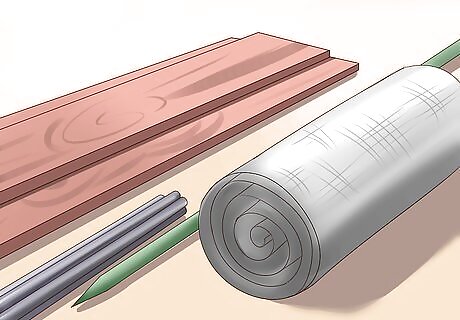
Collect all supplies you need to make your trap. You will need the following: Plywood Chicken wire or hardware cloth Metal dowel rods D 20 nails A fence post or garden stake to anchor the trap Rope or wire
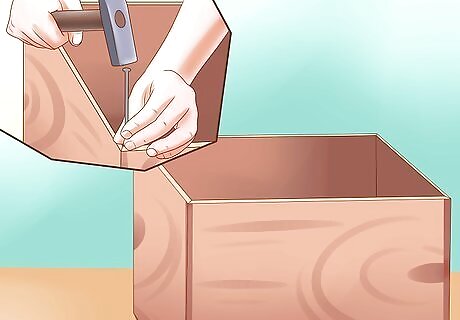
Make a square box frame from plywood. Secure it together with nails. While this method is not the only way to make a turtle trap, it is recommended by fish and wildlife authorities. Make sure the box is large enough to house several turtles at a time. A good rule is to make the box at least 2 ft x 2 ft. Ensure that the box is sturdy and well constructed. It will sit in water so you want to make sure it won't come apart.
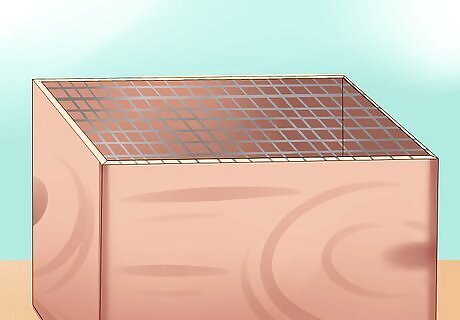
Nail a sheet of chicken wire or hardware cloth over the bottom of the wood frame. This will prevent turtles from escaping. The chicken wire will allow water to enter the trap to keep the turtles wet and comfortable. Nail the chicken wire onto the frame, making sure there aren't any gaps where the wire is loose. Make sure the chicken wire or hardware clot is a fine mesh. You don't want the turtles' feet to get stuck in the wire.
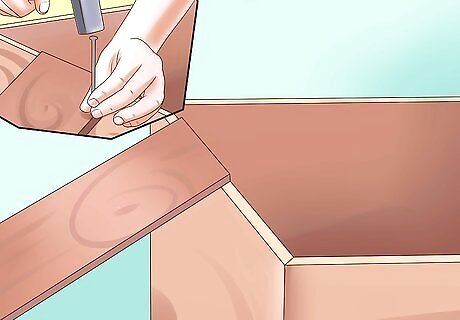
Nail an angled piece of plywood to one side of the outside of the frame. This will serve as a ramp. This ramp will allow turtles to crawl up into the trap. Make sure the ramp is long enough and at a small angle so it is not too steep. Make sure the ramp is tightly nailed to the frame. If it falls off, you won't get any turtles into your trap.
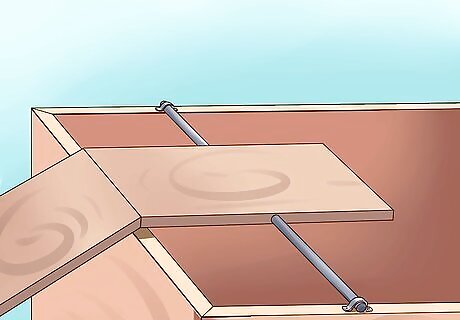
Obtain a metal dowel rod. You will want to pass it through the center of a board of plywood that is smaller than your trap. This will serve as a teeter board. When you trap a turtle, the turtle will crawl up the ramp onto the teeter board. The weight of the turtle will cause the teeter board to tilt and drop the turtle gently into the trap. Attach the teeter board and rod to the top of the frame of the trap. Screw this in just adjacent to the ramp.
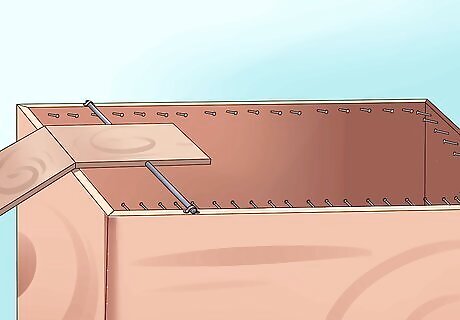
Nail D 20 nails into the sides of the trap. Angle these upwards. Space these every 4 inches (10.2 cm), 2 inches above where the surface of the water in the trap will be. Before you do this you will need to put the trap in the water where you will set it up to see where the water line lies. These nails will prevent the turtles from escaping the trap.

Suspend a piece of tough dried pork or beef from a wire in the trap. This will serve as bait. The turtles will smell this food and be attracted to the trap. After you set up the trap, check this often to see if you need to replace it. Make sure the bait is secure enough that it is not swept away by moving water.
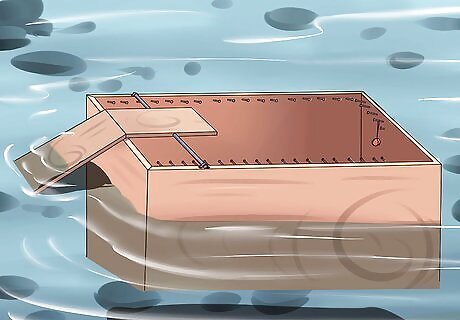
Set up the trap in your desired location. This should be an area where you see turtles resting or feeding along the water's edge. Anchor a fence post or garden stake into the bottom of the pond or creek where you want to set up your trap. Tie the trap to the stake with rope or use strong wire to attach it. Place your trap in the water carefully. Check to make sure it sits in the water with part of it above water. Check your trap everyday to see if you have trapped any turtles.
Caring for Trapped Turtles
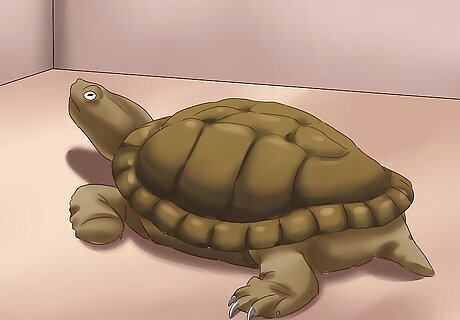
Avoid keeping wild turtles in captivity for too long. You will want to release them to a natural environment. Turtles are wild animals. They will fare better in their own natural environment than in a home or outdoor aquarium. Release turtles by a wild pond or creek. This is their natural habitat. If you can't release the turtles right away, you will need a proper enclosure with enough water, light, shade, and food.
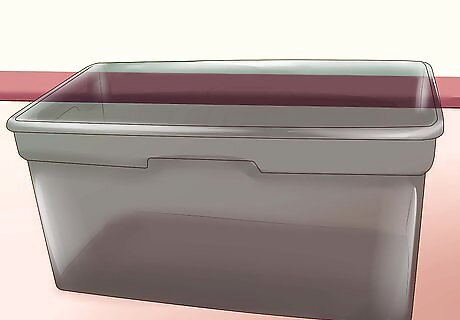
Keep the turtles in a proper enclosure. Wild freshwater turtles generally do well outdoors or in a large indoor enclosure. Avoid keeping them in glass aquariums. They tend to be too small. Try a rubbermaid tub with opaque sides. Turtles in glass or see-through containers will obsessively try to climb through or become afraid by activity in the room. Seriously consider on outdoor trap with adequate sun, shade, water, and weeds. A small pond (either natural or homemade in a tub) is best.
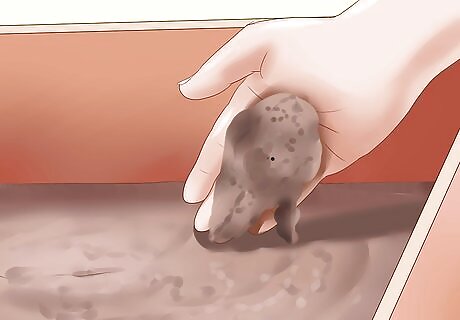
Make sure your enclosure has enough substrate or soil bedding. This acts as a comfortable cushioning for the turtle. A mixture of potting soil, sand, leaf mulch, and sphagnum moss is recommended. Keep this misted everyday to hold humidity. Turtles need a moist, humid environment. Turtles will burrow or nest into the substrate. This makes them feel comfortable. Make the substrate deep enough that the turtle can completely bury itself. Put some flat rocks in the enclosure. This will allow the turtles to sun themselves. Make sure you keep the terrarium or enclosure misted daily. It is very important to keep the turtles habitat very moist or they can develop respiratory problems.
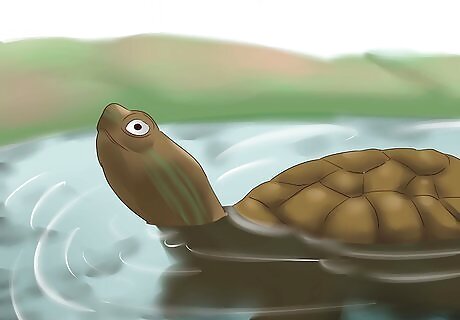
Give the turtles a pond or pool to swim in. Make sure the water is warm so that the turtle does not become disabled if it falls into the water. A shallow pool in a plastic tub will suffice for a pond. Turtles will swim for an hour or more a day. Turtles tend to defecate in their water so it is very important that this is changed everyday.
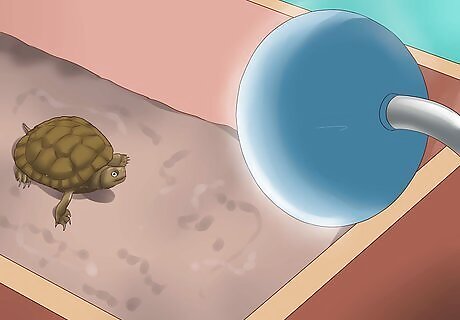
Make sure the enclosure has controlled temperature and light. Outdoor enclosures will need to be heated if the temperature drops below 60 degrees. A ceramic heater will help to keep a colder enclosure warm enough for the turtles. All enclosures should provide a cool area and warm area. In hotter climates, make sure that the turtles have an area where there is lots of shade and soil for burrowing. This will help to keep them from getting overheated. Keeping the enclosure misted will help this issue also. Light is also necessary for keeping the turtles healthy and comfortable. Make sure the turtle has a sunny area in an outdoor trap or buy an incandescent bulb for an indoor enclosure.
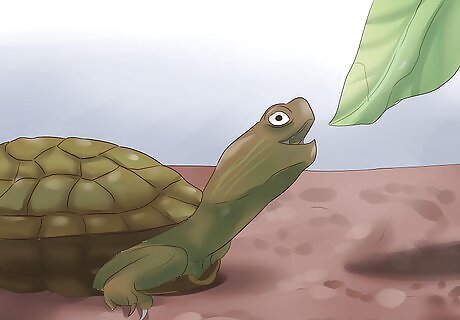
Feed the turtle a variety of foods. Turtles like to eat insects, vegetables, fungus, weeds and even snails. Try feeding the turtle a small "salad" with some lettuce, grated carrot, and a live earthworm. You can also feed them mushrooms and strawberries. You can buy live insects to feed the turtles at pet stores. Feed the turtles on a flat rock instead of in a dish. This is a more natural way for turtles to eat. If a turtle is reluctant to eat, try misting or wetting the turtle ahead of time. Feed them in a warm area of the enclosure.

















Comments
0 comment